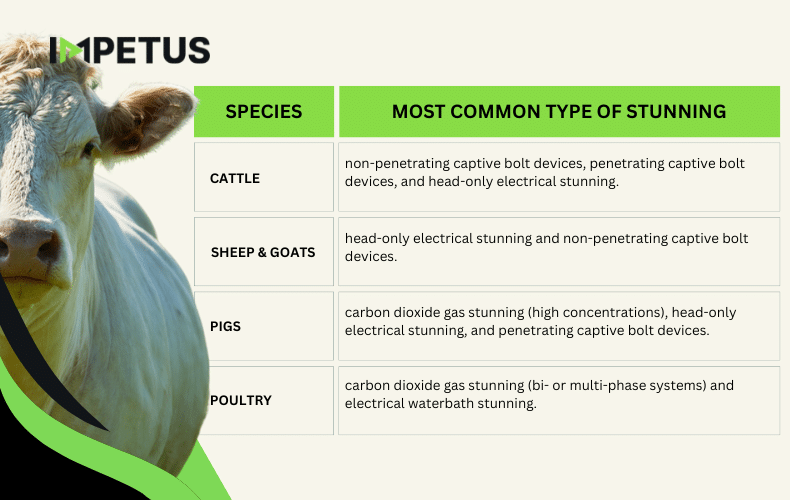How are animals killed for food?
Author: Sarah Babington
In Australia more than 785 million animals (cattle, sheep, pigs, and broiler chickens) were slaughtered from September 2023 to June 2024 (Australian Bureau of Statistics, 2024). Slaughter refers to the act of killing an animal primarily for the purpose of human consumption, which is usually preceded by stunning, a procedure designed to cause loss of consciousness to prevent an animal from experiencing avoidable distress, fear, and pain before death (World Organisation for Animal Health, 2024). Before an animal is slaughtered there are a number of steps that occur from the time the animal leaves the farm until they are slaughtered and further processed into meat and meat products.
How is the slaughter of animals regulated in Australia?
Animals in Australia are slaughtered at commercial slaughtering establishments to produce meat and meat products for both domestic and overseas markets. The food safety and animal welfare requirements at these slaughtering establishments are regulated by various mandatory standards at a commonwealth and state/territory level, as well as voluntary assurance schemes and retail customer requirements. Establishments that only produce meat for domestic consumption are regulated under their relevant state or territory governments, which in most cases will require them to comply with meat processing and animal welfare regulations. Some states, such as NSW and Vic, also allow for meat to be slaughtered and processed through mobile slaughtering units on-farm and sold for domestic consumption. Meanwhile, establishments that are licensed to export meat to overseas markets are regulated by the Commonwealth Australian Government and must comply with specific requirements for each importing country. At export licensed establishments the regulation of animal welfare is considered the responsibility of the relevant state/territory government, which means the role of the Australian Government at these establishments, as it relates to animal welfare, is only to verify compliance with the relevant state/territory animal welfare legislation.
All slaughtering establishments in Australia must comply with the Australia Standard for hygienic production and transportation of meat and meat products for human consumption (AS 4696:2023). Some jurisdictions where stated in the regulations or for licensing conditions require compliance with the Model Code of Practice for the Welfare of Animals: Livestock at Slaughtering Establishments (Model Code of Practice), which includes additional animal welfare requirements. The Model Code of Practice will be replaced by the Australian Animal Welfare Standards and Guidelines for Livestock at Processing Establishments (Standards and Guidelines), which is currently under development. On completion and endorsement from each Agricultural minister the Standards and Guidelines are designed to be implemented by each state/territory government to provide a consistent minimum standard of animal welfare at slaughtering establishments across Australia. There is also the Industry Animal Welfare Standard for Livestock Processing Establishments Preparing Meat for Human Consumption (AAWCS Standard) that underpins the Australian Livestock Processing Industry Animal Welfare Certification System. The AAWCS Standard is formally recognised by the Australian Government as evidence that an export licensed establishment is meeting their legal animal welfare requirements. Similarly, some states in Australia, such as NSW and Qld, require domestic establishments to comply with the AAWCS Standard under licensing conditions.
From farm to slaughter
Transport from farm and arrival
Within the Australian supply chain, animals are typically transported from a farm or feedlot to a slaughtering establishment on a truck or in some cases train (mainly cattle only). Cattle and sheep may be transported from a farm to a saleyard where they are brought and then transported to a slaughtering establishment, whereas pigs and poultry are transported directly from farm to the slaughtering establishment. Animals on arrival at a slaughtering establishment are unloaded from the transport vehicle and moved into pens in a lairage area where water is provided. Poultry are transported in transport modules or crates so on arrival the transport modules are directly unloaded from the transport vehicle and stacked in the lairage area while the poultry remain in their crates (without water) until slaughter.
At unloading and while in the lairage area animals should be inspected before they are slaughtered to identify any disease or welfare conditions that may make them unfit for human consumption or require immediate care, such as treatment or emergency killing. Emergency killing is undertaken by necessity where an animal is identified as having a condition, such as a fracture injury, that is negatively affecting their welfare and would continue to deteriorate unless killed immediately. Once an animal is passed as fit for human consumption, they can be moved from the lairage area up to the stunning area. For animals, other than poultry, this will usually involve personnel manually handling and moving animals from the pens into a raceway that leads up to a stunning area. Poultry are typically kept and moved in their transport modules to the stunning area where they are then unloaded or stunned while remaining in the transport module depending on the stunning system being used.
Stunning
In Australia, animals must be stunned prior to slaughter. There is an exemption for non-stunned kosher slaughter in some jurisdictions. Stunning when effective should render an animal unconscious immediately or in a way that does not cause pain, suffering, or distress, so that the animal is insensible while they are bled out and until death is achieved. The type of restraint and design of the stunning area depends on the species of animal and type of stunning system being used.
The stunning methods used commercially can be classified as mechanical, electrical, and gas stunning systems. Stunning methods can also be classified as reversible where an animal will recover consciousness after the stun if not bled out, and non-reversible where the animal will not recover after the stun even if not bled out. Reversible stunning methods are used in most cases to meet the religious requirements for Halal slaughter, which requires an animal to be alive or deemed alive at the time of slaughter (Abdullah et al., 2019). From a welfare standpoint generally non-reversible stunning methods are preferable because they are more effective at inducing unconsciousness and when applied effectively there is no risk of the animal regaining consciousness while bleeding out and before death is achieved (Oliveira et al., 2018).
The main mechanical stunning methods include firearms, penetrating captive bolt devices, and non-penetrating captive bolt devices (Hewitt & Small, 2022).
Firearms are a non-reversible stunning method that fires a bullet aimed to penetrate through the skull of an animal and directly into the brain causing significant irreversible brain damage, immediate unconsciousness, and in most cases death.
Penetrating captive bolt devices are a non-reversible stunning method that administer a bolt through the cranium and into the brain of an animal causing significant irreversible brain damage and immediate unconsciousness.
Non-penetrating captive bolt devices (sometimes called percussive stunning) are a reversible stunning method that uses a flat or mushroom-shaped bolt to administer a physical blow to the forehead of an animal directly over the brain. The energy created by the physical blow causes impact between the cortex of the brain and skull which disrupts brain activity and resulting temporary unconsciousness.
The main electrical stunning methods include head-only electrical, head-to-body electrical, and electrical waterbath stunning systems (Humane Slaughter Association, 2016; Lambooij & Hindle, 2018). In electrical stunning systems, the choice of electrical parameters (voltage, current, frequency, waveform, and duration) will impact the reversibility of the stun (Hewitt & Small, 2022).
Head-only electrical stunning is a reversible stunning method that applies electrodes on the head of an animal (on each temple or behind each ear) to pass an electrical current through the brain, which induces a generalised epileptiform seizure and unconsciousness.
Head-to-body electrical stunning is a non-reversible stunning method which applies electrodes on the head and body (usually the chest or back) of an animal to first deliver an electrical current through the brain to induce unconsciousness, and then a second electrical current through the body to cause ventricular fibrillation and cardiac arrest.
Electrical waterbath stunning is a generally reversible stunning method used for poultry, in which birds are usually inverted with their legs placed in metal shackles on a moving conveyor line. The conveyor line then moves several birds at the same time through a water bath so that an electrical current is passed from their heads in the water to their feet in the shackles causing a generalised epileptiform seizure and unconsciousness.
The only gas stunning method used for large-scale commercial slaughter is carbon dioxide gas stunning systems (Fuseini et al., 2023; Velarde & Dalmau, 2024). In Australia gas stunning systems are only used for the stunning of pigs and poultry. The concentration and exposure time to the carbon dioxide gas determines whether the system is reversible or non-reversible.
For pigs gas stunning with high concentrations (>80%) of carbon dioxide gas are used. Pigs are typically moved in small groups into a stunning unit which may be pre-filled with carbon dioxide gas, or the unit is lowered into a pit with carbon dioxide gas. On exposure and inhalation of the gas the levels of carbon dioxide increase while the levels of oxygen decrease in the blood of the pigs resulting in a loss of brain function and unconsciousness.
For poultry bi- and multi-phasic gas stunning systems with carbon dioxide gas are usually used. Poultry are kept in their transport modules and moved directly into the stunning unit or tipped out onto a conveyor belt and moved through the stunning unit. In both types of stunning systems, the birds are exposed to carbon dioxide at gradually increasing concentrations with the intent that they lose consciousness at the lower less aversive concentration (<40%) before being exposed to the higher and aversive concentrations. Same as with pigs, as poultry are exposed to and inhale the gas the levels of carbon dioxide increase while the levels of oxygen decrease in their blood resulting in a loss of brain function and unconsciousness.
For the main animal species slaughtered in Australia the most common types of stunning systems used at slaughtering establishments are:

Slaughter
After the stun method is applied to the animal the effectiveness of the stun should be assessed to ensure that the animal is unconscious before slaughter. The signs used to assess unconsciousness will differ depending on the species of animal and the stunning method used. Once unconsciousness has been confirmed, the animal is bled out by having the major blood vessels severed either through a neck cut or thoracic stick to cause death from cerebral anoxia from the loss of circulating blood volume (Hewitt & Small, 2022). Where reversible stunning methods are used effectively, they should keep the animal in an unconscious state during the slaughter process and until resulting in unconsciousness and death from blood loss. The animal is bled out and then death is confirmed before any further processing of the carcase into meat and meat products.
Get the latest updates on our projects and what's going on in animal welfare
References
Abdullah, F. A. A., Borilova, G., & Steinhauserova, I. (2019). Halal criteria versus conventional slaughter technology. Animals, 9(8), 530. https://doi.org/10.3390/ani9080530
Australian Bureau of Statistics. (2024). Livestock Products, Australia. https://www.abs.gov.au/statistics/industry/agriculture/livestock-products-australia/latest-release
Fuseini, A., Miele, M., & Lever, J. (2023). Poultry welfare at slaughter. Poultry, 2(1), 98-110. https://doi.org/10.3390/poultry2010010
Hewitt, L., & Small, A. (2022). An independent scientific review of processing establishment practices for livestock welfare. https://publications.csiro.au/publications/publication/PIcsiro:EP2021-3202
Humane Slaughter Association. (2016). Electrical Stunning of Red Meat Animals. Retrieved 8/10/24, from https://www.hsa.org.uk/electrical-stunning-of-red-meat-animals-introduction/introduction-1
Lambooij, B., & Hindle, V. (2018). Electrical stunning of poultry. In Advances in Poultry Welfare (pp. 77-98). Elsevier. https://doi.org/10.1016/B978-0-08-100915-4.00004-X
Oliveira, S. E. O., Gregory, N. G., Dalla Costa, F. A., Gibson, T. J., Dalla Costa, O. A., & Paranhos da Costa, M. J. R. (2018). Effectiveness of pneumatically powered penetrating and non-penetrating captive bolts in stunning cattle. Meat Science, 140, 9-13. https://doi.org/10.1016/j.meatsci.2018.02.010
Velarde, A., & Dalmau, A. (2024). Slaughter of pigs. In Advances in pig welfare (pp. 351-379). Elsevier. https://doi.org/10.1016/B978-0-08-101012-9.00010-1
World Organisation for Animal Health. (2024). Glossary. In Terrestrial Animal Health Code. https://www.woah.org/en/what-we-do/standards/codes-and-manuals/terrestrial-code-online-access/?id=169&L=1&htmfile=sommaire.htm

